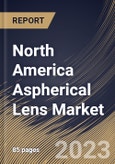Aspheric lenses may be divided into convex and concave categories. In many presbyopic varifocal lenses, convex aspheric curvatures are employed to improve the optical power over a portion of the lens, which is helpful for near-focused activities like reading. An aspheric "progressive add" makes up the reading portion. Additionally, high-plus power aspheric lenses can be prescribed in cases of aphakia or extreme hyperopia; however, this method is fading away in favor of surgical intraocular lens implants.
Regulatory organizations that oversee prescriptions have approved a variety of convex lens varieties. High myopia can be corrected with concave aspheres. However, similar to how a prosthetic is made specifically for a person, they are not readily accessible from optical dispensaries and must be obtained on an individually tailored basis with instructions from the suiting practitioner.
North America represents one of the most lucrative markets for utilizing aspheric lens technology with high precision. Due to distortion, astigmatism, spherical aberration problems, and the country's rapid growth in the automotive and smartphone industries, the region currently controls the majority of the global market for aspheric lenses. The U.S. and Canada have well-established infrastructures in the medical and car industries. Thus, these systems assist technical research and development projects. In addition, these nations have several leading industrial firms thanks to favorable regulatory standards, which have allowed the local market to grow.
The US market dominated the North America Aspherical Lens Market by Country in 2022, and would continue to be a dominant market till 2029; thereby, achieving a market value of $2,696.4 Million by 2029. The Canada market is poised to grow at a CAGR of 8.2% during (2023-2029). Additionally, The Mexico market should witness a CAGR of 7.2% during (2023-2029).
Based on Offering, the market is segmented into Single and Double. Based on Type, the market is segmented into Glass, Plastic, and Others. Based on Manufacturing Technology, the market is segmented into Molding, Polishing & Grinding, and Others. Based on Application, the market is segmented into Opthalmic, Consumer Electronics, Digital Cameras, Automotive, Fiber Optics & Photonics and Others. Based on countries, the market is segmented into U.S., Mexico, Canada, and Rest of North America.
The market research report covers the analysis of key stake holders of the market. Key companies profiled in the report include Nikon Corporation, Canon, Inc., Panasonic Holdings Corporation, Hoya Corporation, Thorlabs, Inc., AGC, Inc., Carl Zeiss AG, Tokai Optical Co., Ltd., Calin Technology Co., Ltd. and Largan Precision Co., Ltd.
Scope of the Study
By Offering
- Single
- Double
By Type
- Glass
- Plastic
- Others
By Manufacturing Technology
- Molding
- Polishing & Grinding
- Others
By Application
- Opthalmic
- Consumer Electronics
- Digital Cameras
- Automotive
- Fiber Optics & Photonics
- Others
By Country
- US
- Canada
- Mexico
- Rest of North America
Key Market Players
List of Companies Profiled in the Report:
- Nikon Corporation
- Canon, Inc.
- Panasonic Holdings Corporation
- Hoya Corporation
- Thorlabs, Inc.
- AGC, Inc.
- Carl Zeiss AG
- Tokai Optical Co., Ltd.
- Calin Technology Co., Ltd.
- Largan Precision Co., Ltd
Unique Offerings
- Exhaustive coverage
- The highest number of Market tables and figures
- Subscription-based model available
- Guaranteed best price
- Assured post sales research support with 10% customization free
Table of Contents
Companies Mentioned
- Nikon Corporation
- Canon, Inc.
- Panasonic Holdings Corporation
- Hoya Corporation
- Thorlabs, Inc.
- AGC, Inc.
- Carl Zeiss AG
- Tokai Optical Co., Ltd.
- Calin Technology Co., Ltd.
- Largan Precision Co., Ltd








